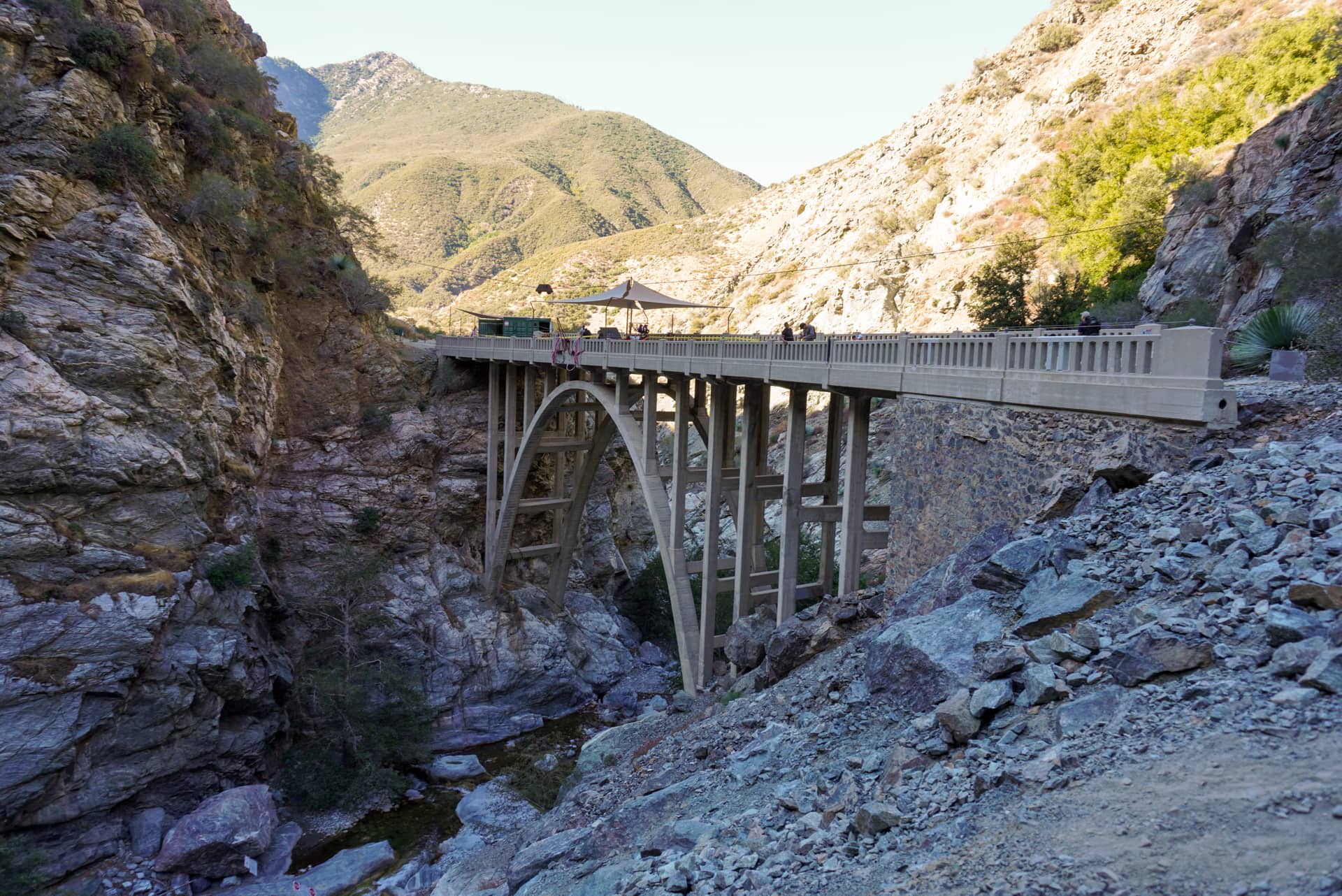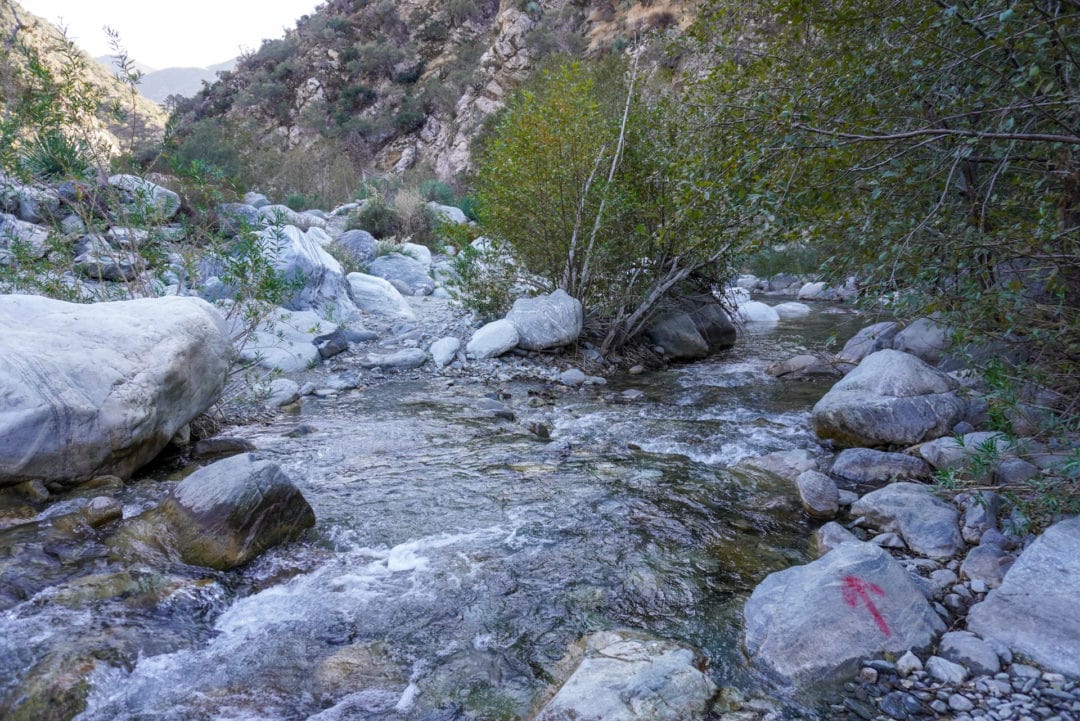“Five, four, three, two, one—BUNGEE!”
The words disappear into an echo above me as I plunge headfirst off a bridge toward the rushing river below. The bungee cords attached to my body harness stretch and contract, tossing me around the canyon before I regain control of my senses and movements.
Key Takeaways
- Bungee America runs government-certified jumps from the remote Bridge to Nowhere every weekend, with a perfect 31-year safety record.
- Reaching the bridge means a ten mile round-trip hike along the San Gabriel River, including six separate river crossings.
- Jump days offer dramatic canyon scenery and varied jumpers, including adventurous couples and a daring 69-year-old participant.
What it Feels Like to Bungee Jump off a 120 Foot Bridge
It’s a magnificent feeling to be suspended mid-air. The momentary terror that precedes the actual jump is soon replaced by something more akin to gratitude—for being alive, certainly, but also for the ability to experience something so disruptive from everyday life.
I’m hoisted back up onto the jumping platform—and then I immediately do it all over again.

Bungee Jumping at the Bridge to Nowhere in Angeles National Forest
How did I end up on this bridge in the middle of Angeles National Forest, a 5-mile hike from the nearest road? It started with getting hooked on bungee jumping during a trip to Costa Rica a few years ago. As soon as I got back to California, I started researching local bungee jumping options. As it turned out, the only government-certified bungee jumping center in California—and anywhere within a 1,000-mile radius of Los Angeles—is Bungee America.
Founded by legendary bungee jumper Ron Jones in 1989, Bungee America coordinates jumps off the scenic Bridge to Nowhere every weekend, all year round. The bridge was built in the 1930s as part of an attempt to connect the San Gabriel Valley to Wrightwood just north of it. But before the new road was even finished, it was washed out during the Los Angeles flood of 1938.
The massive flood killed more than 100 people and destroyed buildings, roads, and bridges all over the county, but the Bridge to Nowhere was left standing. The 120-foot-tall bridge sits in a deep gorge of the valley known as the Narrows, so high above the river that the flood didn’t reach it.

After the catastrophe, the road project was abandoned along with the bridge. Today, Bungee America owns the bridge and the 50 acres surrounding it. It’s a popular hiking destination even for those with no interest in bungee jumping.
Hiking to the Bridge to Nowhere Bungee Jumping Site
It’s a chilly but pleasant November morning as I pull into the parking lot at the Bridge to Nowhere trailhead, a 20-mile drive north from Azusa, California. It’s not even 7 a.m., and while it’s getting lighter by the minute, the sun is still struggling to peek above the San Gabriel Mountains that surround us in all directions.
The Bungee America staff has a check-in table set up in the lot, and once the day’s registered jumpers—about 25 in total—have all arrived, we begin our 5-mile hike as a group. I do my best to keep pace with Alex Gross, who’s leading the excursion. His broad job description includes “bungee jump instructor” and “marketing and special events coordinator” for Bungee America.

How Hard is the Bridge to Nowhere Hike?
“I tell people that if they’ve never done a hike before, this is probably going to be a hard hike, but if you’re used to hiking, this is probably moderate to easy,” he says.
Gross tells me the story of how he landed the job. On a Saturday about a year ago, he went on a night hike to the bridge. “I’m lying there looking at the stars when suddenly, out of the darkness, this white dude in an NRA shirt walks up to me,” he says. “And he goes, ‘Hey, you’re allowed to be here, but just so you know, this is my bridge.’”
The guy turned out to be Jones, the owner of Bungee America. “We sat down and talked for an hour and a half,” Gross says. “Toward the end of it, he was, like, ‘Do you want a job here?’ So, yeah, that was my job interview.”
Here, Gross interrupts himself, points to the ground, and says, “This is poison oak.” He turns around and shouts back to the group behind us, “Poison oak, pass it on!”
Prior to starting his job at Bungee America, Gross had never bungee jumped. Now, his work entails doing the 10-mile round-trip hike multiple times a week, often while carrying heavy bungee jumping equipment. And he does get to jump—time permitting.


Bungee America Safety Record and History in California
The hike is beautiful, winding its way along the San Gabriel River—and even crossing it multiple times. But the real star of the show is the bridge itself. The stunning arch construction is much larger in person than I was expecting, and I immediately feel a surge of nerves at the thought of throwing myself off of it. The industrial-looking bridge creates an astonishing contrast with the tall mountains above and the deep gorge and river below it. For a moment, the entire group is speechless.
Then we meet Jones, a commanding presence on the bridge. His business has a perfect 31-year safety record, which his staff points out multiple times throughout the day. Due to the remote location of the bridge, the entire operation is done off the grid. Safety always comes first—and Jones is convinced that this is what’s kept him in business for so long while his competitors have all folded.
“Since we started in 1989, we’ve had 10 licensed companies in California come in after us and compete against us,” Jones says. “When you are the first, you have to do it better than anybody else, because the competition is coming. They’re going to try to copy you, and you want to be the last man standing. By 1997, we were the last man standing.”

After a safety briefing and lesson on proper jumping form and protocol, the day’s jumpers get to line up based on weight—to ensure the right cords are used—in front of two different jumping platforms. I’m in the very last group, which means I have several hours to watch and talk to the other jumpers.
Liz Zuniga and Alena Gregory have made the drive up from San Diego to bungee jump for the first time. A year earlier, the couple decided to do what they refer to as an “A-to-Z date year.”
“Basically, every other week we do a date with the next letter of the alphabet,” Gregory says. “Back in January, we went axe throwing for A and then we went bowling for B. Now we’re at X and there’s not a whole lot of words that start with X. So we decided to do an extreme sport.”
While Gregory is the more adventurous of the two and has done similar things in the past—including skydiving and parasailing—Zuniga confesses that bungee jumping was a bit much for her. “But since we’ve been dating, I’ve done more things than I’ve ever done in my life,” she says. For their final two A-to-Z dates, Gregory and Zuniga will be staying in a yurt and going to the zoo.

Superman Front Dive and Backwards Plunge Bungee Jumps at the Bridge to Nowhere
“Bungee is predictable,” Jones says. “There’s nothing random about what we’re doing here.”
His words offer a small comfort when it’s finally my turn to jump. I’ve paid for a two-jump package, which means I get to do both the Superman Front Dive and the Backwards Plunge—one jump facing the canyon and one with my back to it. I do the front dive first. Jones and the onlookers count me down in unison: “Five, four, three, two, one…” As they shout the last word—“bungee!”—I’m already plummeting through the air, rapidly approaching the river.
It’s not my first time bungee jumping, and it’s evidently not the last. As soon as the first one is done, I’m immediately turned around to do my second jump. A few people I talk to during the day say they prefer the backwards jump, but the forward one is my personal favorite. I like to see where I’m going.

While we hiked to the bridge together as a group, everyone is encouraged to head back to the parking lot at their own pace. Since it’s Sunday afternoon, the Bungee America staff still has work to do. They need to pack up all their gear and equipment and lock it up in containers before starting their journey back.
I ask Gross whether he ever gets tired of doing this hike every weekend. “No, I love this canyon,” he says. “I love this hike. I love being outside.”
On my way back, the sun is slowly starting to set. Most day hikers have already made their way back, and aside from the soothing sounds of the ever-present San Gabriel River, the trail is eerily quiet. I’m still high on adrenaline from my jumps, and I can easily see why someone wouldn’t mind doing all of this over and over again.
If You Go: Planning a Bridge to Nowhere Bungee Jumping Trip with Bungee America
Bungee America operates at the Bridge to Nowhere every Saturday and Sunday, year-round and weather permitting, and there’s currently a strict COVID-19 protocol in place to keep staff and jumpers safe.








